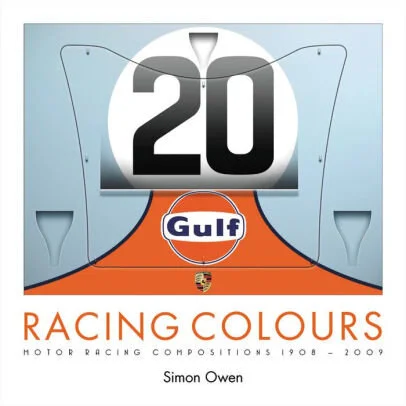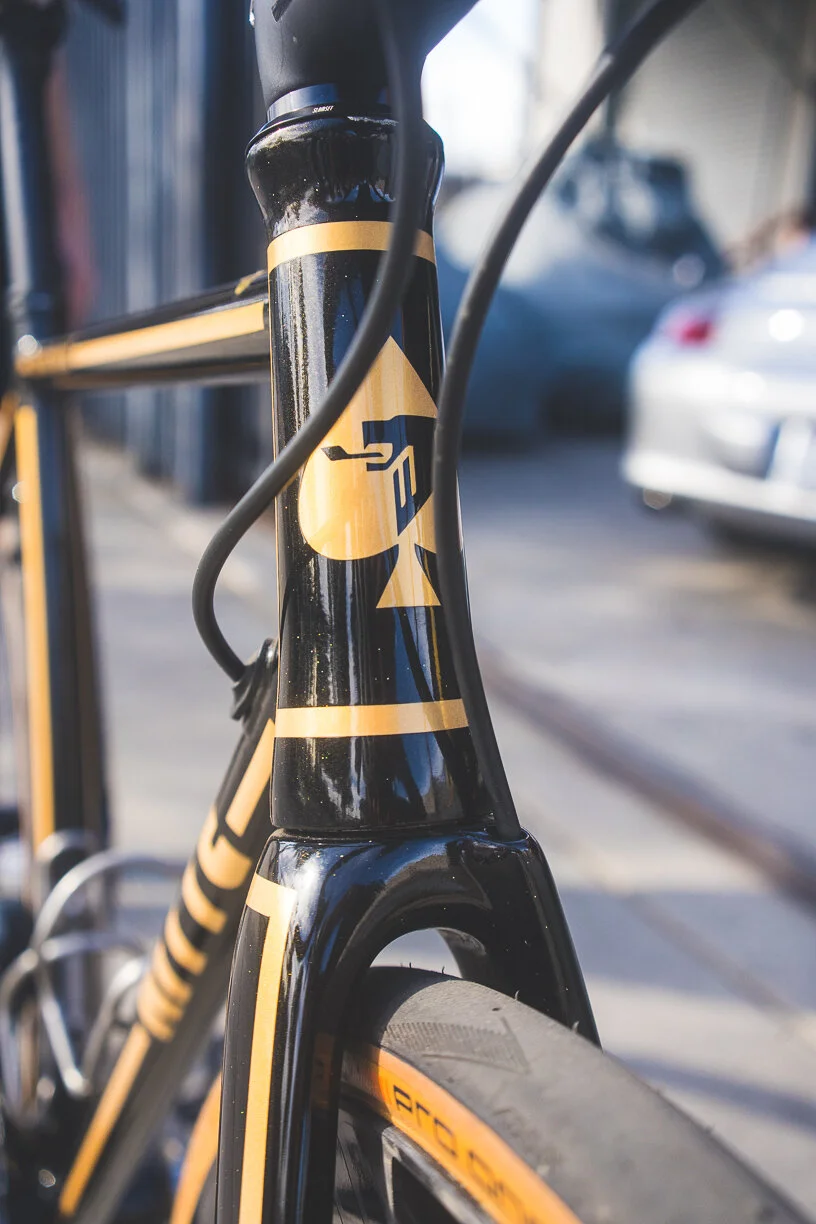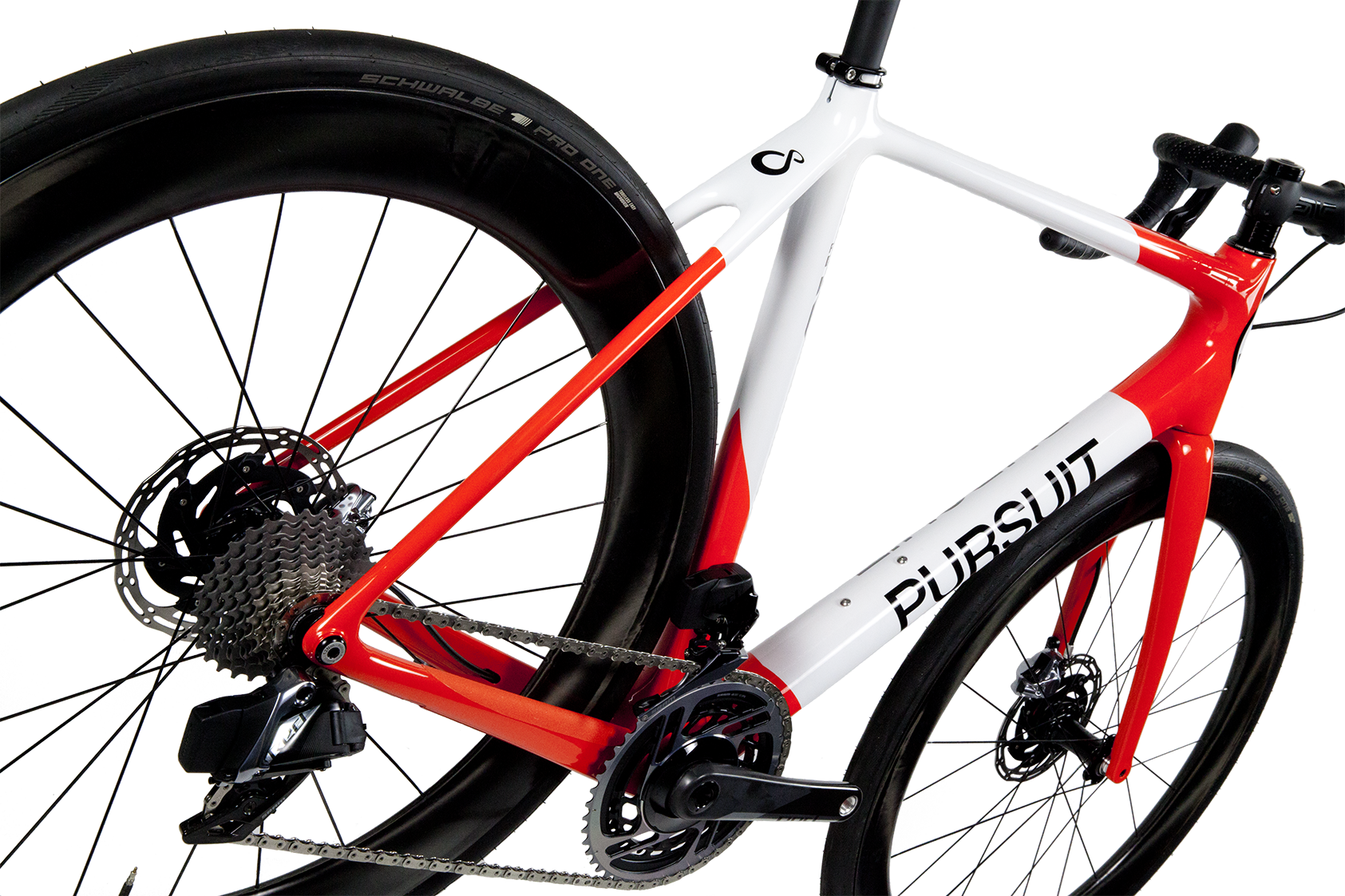Review: Racing Colours
(2020) In the creakybottombracket.com library there are classics, contemporary, non-fiction, god knows what else. Hidden away on the unsorted shelves is a book that was a gift. This book, Racing Colours by Simon Owen is a collection of racing liveries accompanied by a matched quote. Flipping through the pages is a trip back into motor racing history. All the great cars are featured: Lotus, McLaren, Ford, Porsche, and many more. The stars of the book are the racing colors: Gulf, Marlboro, John Player Special, Martini, Sunoco.
Over the past few years we have witnessed gorgeous custom bikes featured with famous racing liveries. These are the custom paint finishings to bikes that turn our heads. Much like the race cars of the past, we want to move in to have a better look at the detail of the paint. Did they get the striping right? Is the color correct? Just how attentive to livery detail did they get? We got in contact with two incredible bike companies who have recently featured a famous livery and decided to explore the bike,the livery, and the book all at once. We start with one of the most iconic liveries in all of motorsports. Excuse us if the colors look familiar:
Gulf-Ritte #20
Though famous the world over, Gulf’s arrival in motorsports started at the famed Indianapolis Motor Speedway in the 1930s. Per the Gulf website, the oil company backed the Gulf-Miller group of cars that were ahead of their time. They were four-wheel drive rear engine cars looking to win the 500. Though the cars did not perform well, Gulf maintained their American presence at the Bonneville Salt Flats setting records.
Fast-forward three decades and Gulf decided a change was necessary. The dark blue and orange was considered too muted and the switch was made to powder blue and orange. The colors have become so recognizable that Gulf has trademarked their racing colors. These racing colors would debut at Le Mans in 1967 and roll into victory lane draped over a Ford GT40 in 1968, Gulf’s first win. Arguable one person took the Gulf colors to stardom.
In 1971 Steve McQueen, actor and professional race car driver, starred in the movie Le Mans. The car in which McQueen piloted was a Porsche 917 cloaked in the Gulf powder blue and orange. Among car fans it is hard to decipher which talent they like better: McQueen or the Porsche 917.
Photos courtesy Elijah Grundel/ Ritte Bicycles
A couple years ago the bike company Ritte offered a limited edition race bike adorned with the Gulf livery. Officially licensed by Gulf, a few lucky people were able to get their hands on the limited edition steed. The bike’s detail is an experience in time. The striking lines between powder blue and orange are as dramatic on the bike as they were on the Porsche 917. Keeping with the European connection the bike is outfitted with a Campy drivetrain. But there are two easter eggs planted in the bike build.
There are two impressive details on the Gulf-Ritte #20 that verify its genius color and build as an homage to the Porsche beast that charged down the Mulsanne Straight. McQueen’s number 20 can be found on the seat tube beneath the top tube. But it is slightly hidden on the inside of the fork, too. Then there is the part that has set itself apart from the dramatic Gulf colors. On both the Porsche 917 and the Gulf-Ritte #20 build, the wheels and tires take on an impenetrable black. Here is a machine with bright colors on top and the contrasting black contacting the asphalt. Ritte’s livery folds contrasts throughout the bike, and racing aficionados would agree this is a proper example of featuring the Gulf colors.
In Simon Owen’s book, he features the Gulf livery expectedly. Opposing the sketch, complete with the white number panel and 20 in it is the famous Steve McQueen quote many bike racers can recognize, “When you’re racing, it’s life. Anything that happens before or after … it’s just waiting.” Like the Gulf-Ritte #20, Simon Owen liked the Porsche 917 livery so much he put it on the cover. One can’t argue with that status.
Ayrton Senna
Smartly Simon Owen gives one of the greatest drivers his own livery. On its own page are the recognizable Brazilian colors of Ayrton Senna’s helmet. The deep yellow with almost sparkling green stripes holds the place for the McLaren MP4/4, a car mythical in its power and demand on its driver. Before we get to the most cannibalistic car in the world, Senna had to get his start somewhere. Demonstrating his worth, Senna established himself a rising star in the John Player Special Lotus 97T in 1985. (Senna seemed to appreciate driving for cigarette brands with Camel, John Player Special, and Marlboro.) It would be in the Lotus Senna would bag his first victory.
What more could be said about Ayrton Senna? He was a driver who thrived in conditions unwelcomed by other drivers. He took cars to the front that had no business being there. The Honda-powered Lotus was instantly recognizable, and the livery - instigated by the famous Colin Chapman - saw other famous drivers behind the black and gold: Emerson Fittipaldi and Mario Andretti to name two. It could be said Senna made this livery even more appealing because of the stigma.
Ritte Bicycles Phantom Special
Ritte Bicycles Phantom Special
Ode to the John Player Special Lotus
Back to Ritte who has offered an ode to an iconic auto racing livery. Dubbed the Phantom Special, Ritte has again gone above and beyond with researched colors. The frame features the expected dramatic contrasts of black with tan accents. Look closely and the bike has a tie to our Pennsylvania area - Tom Kellogg’s signature is featured on the non-drive side chainstay. Though we talk about Senna, the fork is adorned with a gold number plate and numeral one. This is Emerson Fittipaldi’s number in 1973 piloting the Lotus 72E.
The Ritte Phantom Special is equipped with SRAM E-tap, ENVE components, and Chris King hubs. Photo courtesy Elijah Grundel/ Ritte Bicycles.
Ritte has taken the livery and accented it with modern-day cycling wares. The frame rolls on ENVE wheels and Chris King hubs. The seat post and cockpit feature further parts by ENVE, and the bike is powered by SRAM. Schwalbe gumwall Pro One TT tires complement the tan striping John Player Specials were known for. Taken as a whole, the bike echoes the paddock revs of the past. It may even be a bike that inspires the rider to excel in wet conditions, taking minutes on rivals who bemoan the standing water and technical conditions. The bike is a head-turner and conversation starter. What is attractive about the conversations is the potential to discuss classic Formula One liveries with the person.
Pursuit Rouleur
Pursuit Cycles
Ode to the Mclaren MP4/4
Think of the most dominant Formula One car ever. It most likely featured the bright red/orange front and rear with a midship white field. If the description fits, it also had black wheels to add to the menacing role of a pure racer’s car. Piloting the McLaren MP4/4 is a driver with a gold helmet accented with green stripes. The car remains attractive to Formula One drivers. If you don’t believe me, watch Lewis Hamilton’s reaction when he is granted permission to pilot the beast. He is quoted speaking to the radio that he didn’t want to clear the track. The screaming engine, the hand-operated gearbox, the grainy onboard footage, the bouncing yellow/ green helmet are all memories from the McLaren-Honda capable of producing 700 horsepower.
Pursuit Cycles’ Rouleur can be set up with SRAM E-tap and ENVE components. Photo courtesy Carl Strong/ Pursuit Cycles.
Pursuit Cycles out of Bozeman, MT, took the livery of the McLaren-Honda MP4/4 and ran with it. One could imagine the throttle cable being manipulated in the garage by technicians when seeing the Pursuit Cycles Rouleur. The bright red/orange ends are broken up smartly by the white angular fields as on the MP4/4. It’s as if the bike could deafen our ears with a high speed pass. Just as the Senna car, Pursuit Cycles’ Rouleur is built with the same dark wheels and cockpit. Just as the Ritte, the wheels and cockpit feature ENVE components and SRAM drivetrain. Similarly the build rolls on Schwalbe tires for a truly speedy look. Making a bike to emulate what is arguably the most dominant Formula One car ever - which had a winning percentage of 93% - is exciting to see.
These motorsport themed bikes are neither run-of-the mill liveries nor industry standard. The celebrated racing colors live on with these bike builders as do the cars and drivers who made them famous. They come from the era of maddening cars, wingtip vortices, and sparking skid plates. In Simon Owen’s book, Racing Colours, here are many more pages to leaf through. This is good because more classic motorsport themes will grace custom bikes.










